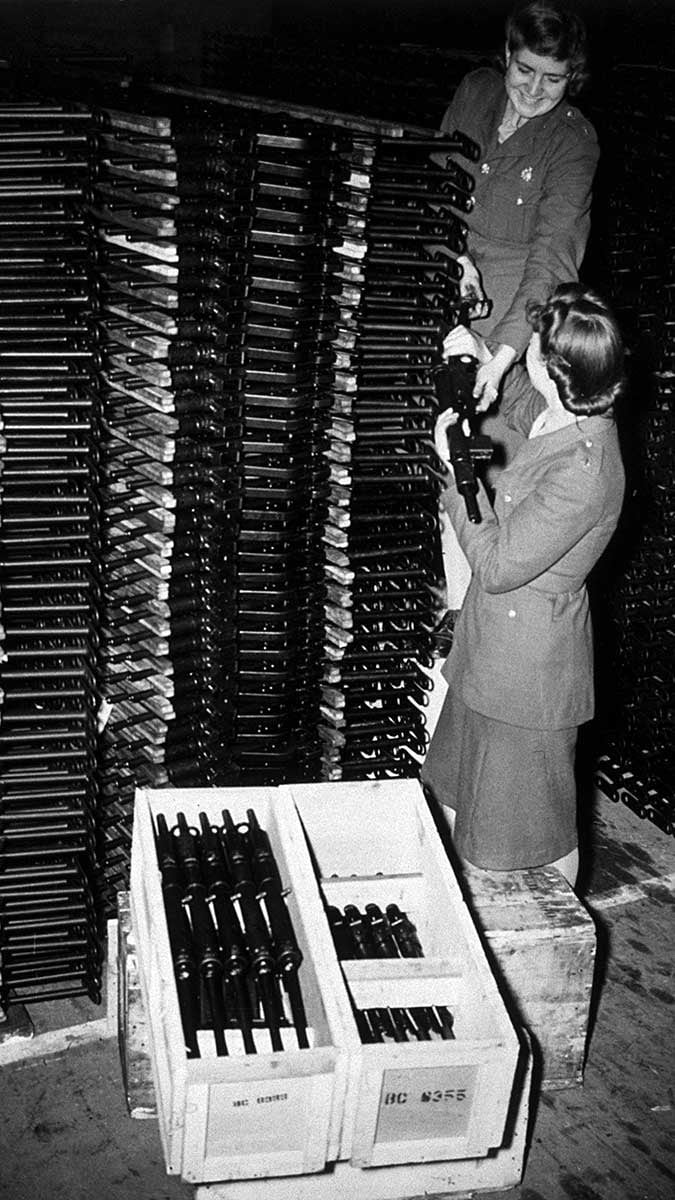There are many outstanding firearms developed during World War II, but none combined down-to-basics simplicity with the cost-cutting frugality of the Sten gun.
The necessity that mothered this invention was the disastrous French campaign of May-June 1940 and the Allied evacuation of Dunkirk, which saved thousands of British and French soldiers but left behind an arsenal’s worth of their weapons. As Britain steeled itself for the coming German invasion threat, its defenders needed a lot of guns — and they needed them fast.
In the automatic fire department, the British bought up all the American-made Thompson submachine guns they could find, but those weapons were expensive and few were available. To tide things over, the Royal Small Arms Factory, Enfield was called upon to design something suitable.
Enter Maj. Reginald V. Shepherd and Harold J. Turpin, who came up with a blowback-operated submachine gun (SMG), firing from an open bolt with a fixed firing pin on the bolt’s face. Based on the Royal Navy’s Lanchester SMG (itself based on the German MP 28), their creation, which bore their initials and the manufacturer’s — S, T, EN — was much more austere, keeping machined components to a minimum while mainly using stamped metal parts.
The result was an unprepossessing weapon produced at half the price of an American M3 “grease gun” and some 20 times less than a Thompson. While its 32-round magazine was side-mounted to the left as on the Lanchester, it could just as easily receive the Lanchester’s 50-round magazine. For that matter, its 9x19mm ammunition was compatible with a variety of other countries’ rounds, including Germany’s, a trait that would figure prominently in the Sten’s future.

By the time the Sten gun began entering service in 1941, the Battle of Britain and the threat of German invasion had passed and Britain was exploring a variety of ways of taking the war to the enemy.
While its inventors continued to refine their Spartan weapon in a variety of improving marks from II to VI (including the Marks IIS and VI, which featured integral sound suppressors), the Sten gun found an avid employer in the Special Operations Executive. The SOE distributed Stens by the thousands among resistance groups throughout occupied Europe, in addition to which many such groups, like the French, Belgians, Norwegians, Danes and Poles established cottage industries for producing their own versions of the simple weapon.
The Sten had only 47 parts and by 1942 the Enfield plant was producing them at a cost of 2.3 pounds ($10) each. The gun weighed 7.1 pounds, to which the magazine added another two pounds. The barrel made up 7.7 inches of its 30-inch length and it could quickly be broken down and hidden anywhere. Pressing a stud could select semiautomatic or fully automatic fire.
On the debit side, while the Sten was officially specified to have a muzzle velocity of 1,198 feet per second, a rate of fire of 500 to 600 rounds per minute and an effective range of 100 feet, many of the guns fell short of that performance, some proving inaccurate beyond 30 feet.
Such inconsistency reflected the spectrum of subcontractors, from Enfield and other major factories to small manufacturing businesses, that produced the weapons or components for them. Quality inevitably varied, with Canadian-built weapons, for example, revealing a bit of extra care in their production, resulting in somewhat better reliability and overall performance in the field, where it counted most.
Properly cleaned and maintained, the Sten could be as dependable as it could be devastating. There were, nevertheless, cases reported of jamming and even of worn-out guns going into fully automatic firing mode if too-roughly handled.
Nevertheless, the Sten gun became an iconic mainstay of SOE and all the resistance cells with whom it operated, from Europe to the Far East. Ironically, as the war turned irreversibly against them, the Germans began producing a version of their own for the Landwehr, the Maschinenpistole MP 3008, which differed from the British original primarily in mounting its magazine on the bottom, rather than the side.

A total of anywhere from 3.7 to 4.6 million Sten guns in its various incarnations were produced during World War II. In 1953 the more sophisticated Sterling SMG was adopted by the British Army and it began phasing its Stens out throughout the 1960s.
These found their way into the hands of guerrilla forces throughout the world and Stens turned up in just about every war fought in the Third World during the 1960s and 1970s, reinforcing for all time its historic association with wars of resistance — on one side or the other, or frequently on both.





